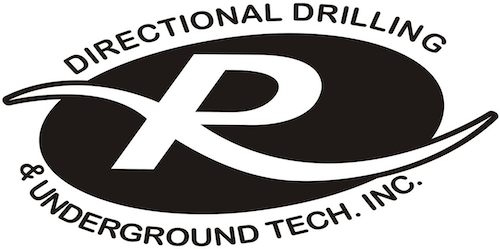Our Services
R Directional Drilling & Underground Technology, Inc. provides services to many clients including utility companies, commercial & residential markets, and federal & state governmental agencies.
Horizontal Directional Drilling
Horizontal directional drilling is an innovative trenchless technology that enables us to install underground utilities without conventional open trenching, as well as obtaining sub-surface information in areas previously inaccessible.
Open Trenching
We have expanded our capabilities to include conventional open trenching methods in moving towards “turnkey” solutions for our client’s underground needs.
Vacuum Potholing & Excavation
While vacuum potholing has always been used during the horizontal drilling operations, the need by our clients for stand-alone vacuum pothole services has become apparent.
Vertical Drilling
R Directional concrete and vertical drilling division utilizes Bay Shore Systems that specializes in using advanced drilling equipment such as the LODRILL TR60 and the Drill Sergeant attachment.
Fiber Optics Solutions
Arial and underground installations, turnkey project fulfillment, fiber splicing capability, and more!
Asphalt & Concrete Repair
We have our own in-house restoration division for all of your asphalt needs. We have restoration crews in each division with complete set-ups to perform repairs.
Concrete Pole Foundation & Substation
R Directional Drilling & Underground Technology, Inc. provides concrete pole foundation and commercial substation concrete foundation services.
24-Hour Emergency Services
24-hour on-call availability with response personnel and equipment on standby and ready to be at your service.
We Got Your Back
Our Experience Speaks For Itself
Years In The Business
Footage of underground installed to date
Safety Training
Underground Drilling Safety
3 to 4 day New Hire Orientation (NHO)
Comprehensive Job Site Safety Observations
Job Hazard Analysis
DOT & CSA Training
First Aid, CPR, AED Training
Damage Prevention
Competent Person
Confined Space
Forklift Training
Slips Trips and Falls
Working and Walking Surfaces
Personal Protective Equipment
Work Zone safety
Ladders and Scaffolding
Hazard Communications
Trench Excavation Safety

Services
Vertical Drilling
R Directional concrete and vertical drilling division utilizes Bay Shore Systems that specializes in using advanced drilling equipment such as the LODRILL TR60 and the Drill Sergeant attachment. The LODRILL TR60 is a hydraulic drilling rig that can reach depths of up to 80 feet and features a compact design for easy transportation to job sites. It also has a powerful engine and hydraulic system, providing high torque and drilling speed. The Drill Sergeant attachment, on the other hand, is designed for vertical drilling applications and can be used with the LODRILL TR60 or other drilling rigs.
Services
Concrete Pole Foundation & Substation
R Directional Drilling & Underground Technology, Inc. provides concrete pole foundation and commercial substation concrete foundation services. Their expertise in foundation drilling and use of advanced equipment allows them to create stable and durable foundations for utility poles and commercial substations. With their experienced professionals and efficient drilling solutions, R Directional is able to offer high-quality and reliable foundation services for a variety of projects.
Services
Vacuum Potholing
In addition to utilizing hydrovacs for horizontal directional drilling support, we offer comprehensive services including potholing and hydro excavation. Our fleet includes high cfm hydrovacs and dry air vac systems, ensuring safe, non-destructive excavation for utilities, while minimizing disruption and maintaining the highest safety standards
Services
Open Trenching
We have expanded our services to include conventional open trenching methods as part of our commitment to offering comprehensive “turnkey” solutions for our clients underground utility needs. We operate fully staffed and equipped trenching crews. Each crew is outfitted with a backhoe or mini excavator, a 5-yard dump truck, a 1-ton crew truck, and an air compressor with a jackhammer and tamper.
All field employees are OSHA certified and receive specialized training on trench and shoring safety.
Services
Fiber Optics Solutions
- Fiber Splicing Capability
- Underground cable placement and aerial installations
- Aerial bucket trucks
- Fiber splicing truck & trailer units
- Wreck Out
- All RDD field employees are OSHA certified & trained in a confined space
- Backbone & Lateral Fiber
- Telco owned leased duct
- Path verification & route design
- Proofing
- UG & AR Make Ready As-builts

Services
Asphalt & Concrete Repair
|
|
Services
24-Hour Emergency Services
|
|
Services
Horizontal Directional Drilling
Our fleet includes over 30 Vermeer directional drills, ranging from the 10×15 model, which has a pulling capacity of 10,000 lbs, to one of the largest drills in the Southwest, the 220×300, capable of pulling in 242,000 lbs of product. We have set industry records with our 24×40 and 80×100 Vermeer drills, achieving pulling capacities of 54,000 lbs and 139,000 lbs, respectively.
We possess the capability and equipment to execute large bores up to 36 inches in diameter and long-distance bores extending up to 2,500 feet. Our innovative approaches, including mud recycling, mud-driven downhole motors, aggressive tri-cone bits, air hammers, and the use of larger drills, position R Directional Drilling as the premier choice for rock and specialty large bore projects.
Horizontal Directional Drilling & Underground Construction Services
R Directional Drilling & Underground Technology, Inc. specializes in completing bores in various ground conditions, including dirt, cobble, and rock. We are equipped to handle bores ranging from 2″ to 36″ in diameter, facilitating the installation of conduit or pipe for a wide range of underground utilities, such as electric, gas, telecommunications, cable, water, and sewer.
Each project is tailored to the unique requirements of the client and the specific ground conditions. Pricing is determined based on the scope of the project, ground conditions, required materials, labor hours, and equipment usage. Our goal is to provide efficient, high-quality solutions that meet the demands of any underground utility installation.
What is Horizontal Directional Drilling?
Horizontal Directional Drilling (HDD) is a trenchless technology used to install underground utilities, such as pipelines, conduits, and cables, with minimal surface disruption. The process involves three main stages: drilling a pilot bore along a predetermined path, enlarging the borehole with reaming tools, and pulling the utility through the expanded bore. HDD is commonly used to navigate beneath obstacles like roads, rivers, or buildings, where traditional open trenching is impractical or too disruptive.
The Benefits of Directional Drilling
- Minimal Surface Disruption: HDD eliminates the need for open trenching, preserving existing landscapes and infrastructure.
- Cost-Effective: Reduces restoration costs and minimizes downtime by avoiding major excavation.
- Environmentally Friendly: Protects ecosystems and reduces environmental impact, particularly in sensitive areas.
- Versatile: Can be used in a variety of ground conditions and over long distances, making it adaptable to different project needs.
- Faster Project Completion: HDD reduces the time required for installation compared to traditional trenching methods, improving project efficiency.
